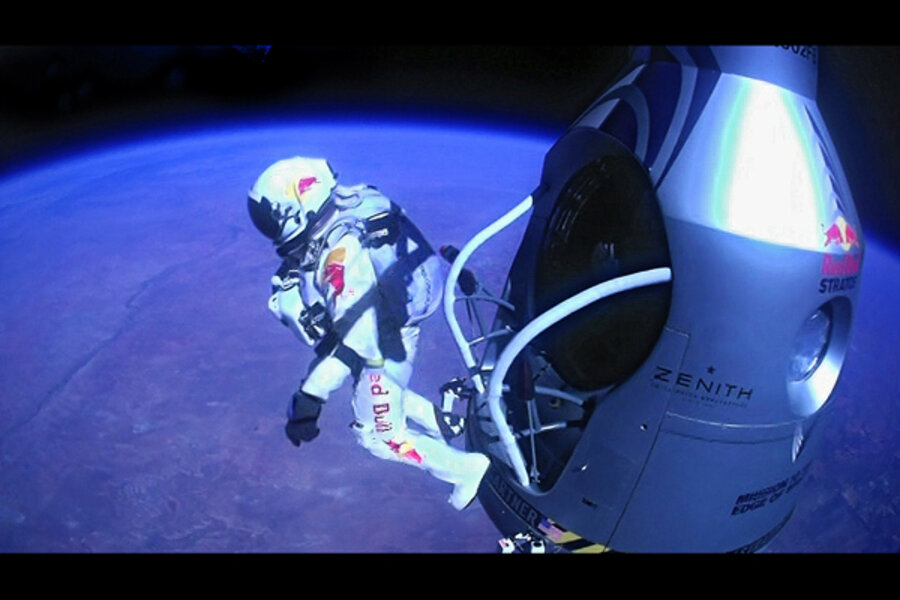Red Bull skydiver fell even faster than we thought
Loading...
| Cape Canaveral, Fla.
Supersonic Austrian skydiver Felix Baumgartner was faster than he or anyone else thought during his record-setting jump last October from 24 miles (38 kilometers) up.
The parachutist known as "Fearless Felix" reached 843.6 mph (1,357 kph), according to official numbers released Monday. That's equivalent to Mach 1.25, or 1.25 times the speed of sound.
His top speed initially was estimated at 10 mph (16 kph) slower at 834 mph (1,342 kph), or Mach 1.24.
Either way, he became the first human to break the sound barrier with only his body. He wore a pressurized suit and hopped from a capsule hoisted by a giant helium balloon over New Mexico.
Baumgartner was supersonic for a half-minute — "quite remarkable," according to Brian Utley, the record-keeping official who was present for the Oct. 14 feat.
The 43-year-old's heart rate remained below 185 beats a minute, and his breathing was fairly steady.
The leap was from an altitude of 127,852 feet (38,969 meters). That's 248 feet (75 meters) lower than original estimates, but still stratospheric.
"He jumped from a little bit lower, but he actually went a little bit faster, which was pretty exciting," said Art Thompson, technical project director for the RedBull-sponsored project.
"It's fun for us to see reaching Mach speeds and proving out a lot of the safety systems," Thompson said in a phone interview from his aerospace company in Lancaster, California.
Thompson said everything pretty much unfolded as anticipated, with no big surprises in the final report. The updated records were provided by Utley, official observer for the National Aeronautic Association's contest and records board. Utley was in Roswell, New Mexico, for Baumgartner's grand finale following two test jumps.
Based on all the data collected from sensors on Baumgartner's suit, Utley determined that Baumgartner was 34 seconds into his jump when he reached Mach 1. The speed for breaking the sound barrier depends on the temperature at a given altitude; for Baumgartner, that came together just shy of 110,000 feet (33,528 meters).
He reached peak speed by the time he was at 91,300 feet (27,800 meters), 50 seconds into the jump, and was back to subsonic by 75,300 feet (23,000 meters), give or take, 64 seconds into his free fall.
His entire free fall lasted four minutes, 20 seconds. He used a parachute to cover the final 5,000 feet (1,500 meters), landing on his feet in the desert outside Roswell.
Not everything went well.
Baumgartner went into a dreaded flat spin while still supersonic. He spun for 13 seconds at approximately 60 revolutions per minute, making 14 to 16 spins before using his body to regain control, Thompson said. The skydiver was well within safety limits the entire time, he noted. Baumgartner's brain remained under 2G, or two times the force of gravity, during the spin.
If the flat spin had lasted longer and been more severe — exceeding six continuous seconds at 3.5 G — Baumgartner's drogue, or stabilizing, parachute would have deployed automatically. Doctors worried about him blacking out and suffering a stroke or, in the case of a suit tear, his blood boiling at such an extreme altitude. The outside temperature registered as low as minus 96 Fahrenheit (-71 Celsius).
In the foreword of the 71-page report, Baumgartner said he never imagined how many people would share in his dream to make a supersonic free fall from so high.
Some 52 million people watched YouTube's live stream of the exploit.
The scientific and engineering experts who helped bring him back alive "broke boundaries in their own fields just as surely as I broke the sound barrier," Baumgartner wrote.
Baumgartner shattered the previous record set by Joe Kittinger, an Air Force officer, in 1960. Kittinger did not quite reach supersonic speed during his jump from 19.5 miles (31 kilometers) up.
Kittinger noted in the Red Bull Stratos report (Stratos for stratosphere) that future work is needed to test a stabilizing parachute for use at extreme altitudes.
The private project was aimed, from the start, at helping future space crews — whether NASA or commercial — survive high-altitude accidents.
If a highly trained jumper like Baumgartner with 2,500 jumps couldn't prevent a flat spin, "an astronaut, pilot or space tourist could not overcome this spinning probability," Kittinger wrote.
Thompson agreed, noting that given the right safety gear and the right conditions, there's "a remote possibility" a space crew could survive even under such harsh circumstances as were faced by the space shuttle Columbia astronauts.
All seven astronauts perished as Columbia returned to Earth on Feb. 1, 2003. One of the crew, Laurel Clark, was married to the former NASA flight surgeon who led Baumgartner's medical team, Dr. Jonathan Clark.
"You never know what the possibilities are ... that's the direction we need to look at," Thompson said.







